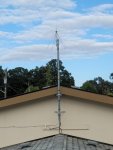First post, hello! I've read countless pages and posts on this site, and 10 months into my slow project I think it's time I ask for what things I can do better or what I may have missed. Reassurance would be appreciated too.
History: Started with a single cheap $35 SDR-RTL USB and dipole a year or two ago. I enjoyed it and wanted to install an antenna, get a real scanner, with possibly getting a CB and more.
Goal: Scanning based equipment at first, ~770 MHz (P25) and ~150 (NFM), and expand from there. I had a few CB radios as a teenager, and that was a lot of fun.
I've mounted a discone antenna on the top of the house, grounded the 10ft mast, grounded polyphaser. This past weekend I just ran about 70ft of "USA-Flex 400" coax and am ready to drill a hole in the wall. It's not LMR-400 but it's much better than my existing RG174.
For all external connections, I've gone with the N type connections. For internal, I suspect I'll end up with BNC for most.
This week I'll order a stridsberg multicoupler (MCA208M BNC or N input). I don't know if that comes with a power supply or if I have to sort that out too.
- Other than a multimeter on each section, what equipment can I obtain to check the cable and signal is good along the path?
- What inline component in the office can measure the signal/quality of the signals I am receiving?
- What high quality flexible cable should I use (patch cables) for the last 6 feet between the multicoupler and receivers?
- Do I need to install a second polyphaser immediately before house entry?
- What other equipment/filters/components should I look into?
- I grabbed a bunch of "Snap-on Ferrite" magnets. Do I just clip these near both cable ends, then one or two in the middle?
I'm also seeking recommendations / links on;
- A coaxial switcher. At some point I'll want to buy equipment that can transmit too. Instead of unplugging and reconnecting antenna feed coax from the multicoupler to another patch cable, I'd like a high quality low loss coax switcher.
- Weatherproofing and cosmetic hardware, like an "exterior cable guard" to cover the hole where the feed comes into the house.
My apologies if any of the above seem to be silly questions or unclear. I can post more details if needed.
Thank you in advance!
History: Started with a single cheap $35 SDR-RTL USB and dipole a year or two ago. I enjoyed it and wanted to install an antenna, get a real scanner, with possibly getting a CB and more.
Goal: Scanning based equipment at first, ~770 MHz (P25) and ~150 (NFM), and expand from there. I had a few CB radios as a teenager, and that was a lot of fun.
I've mounted a discone antenna on the top of the house, grounded the 10ft mast, grounded polyphaser. This past weekend I just ran about 70ft of "USA-Flex 400" coax and am ready to drill a hole in the wall. It's not LMR-400 but it's much better than my existing RG174.
For all external connections, I've gone with the N type connections. For internal, I suspect I'll end up with BNC for most.
This week I'll order a stridsberg multicoupler (MCA208M BNC or N input). I don't know if that comes with a power supply or if I have to sort that out too.
- Other than a multimeter on each section, what equipment can I obtain to check the cable and signal is good along the path?
- What inline component in the office can measure the signal/quality of the signals I am receiving?
- What high quality flexible cable should I use (patch cables) for the last 6 feet between the multicoupler and receivers?
- Do I need to install a second polyphaser immediately before house entry?
- What other equipment/filters/components should I look into?
- I grabbed a bunch of "Snap-on Ferrite" magnets. Do I just clip these near both cable ends, then one or two in the middle?
I'm also seeking recommendations / links on;
- A coaxial switcher. At some point I'll want to buy equipment that can transmit too. Instead of unplugging and reconnecting antenna feed coax from the multicoupler to another patch cable, I'd like a high quality low loss coax switcher.
- Weatherproofing and cosmetic hardware, like an "exterior cable guard" to cover the hole where the feed comes into the house.
My apologies if any of the above seem to be silly questions or unclear. I can post more details if needed.
Thank you in advance!


